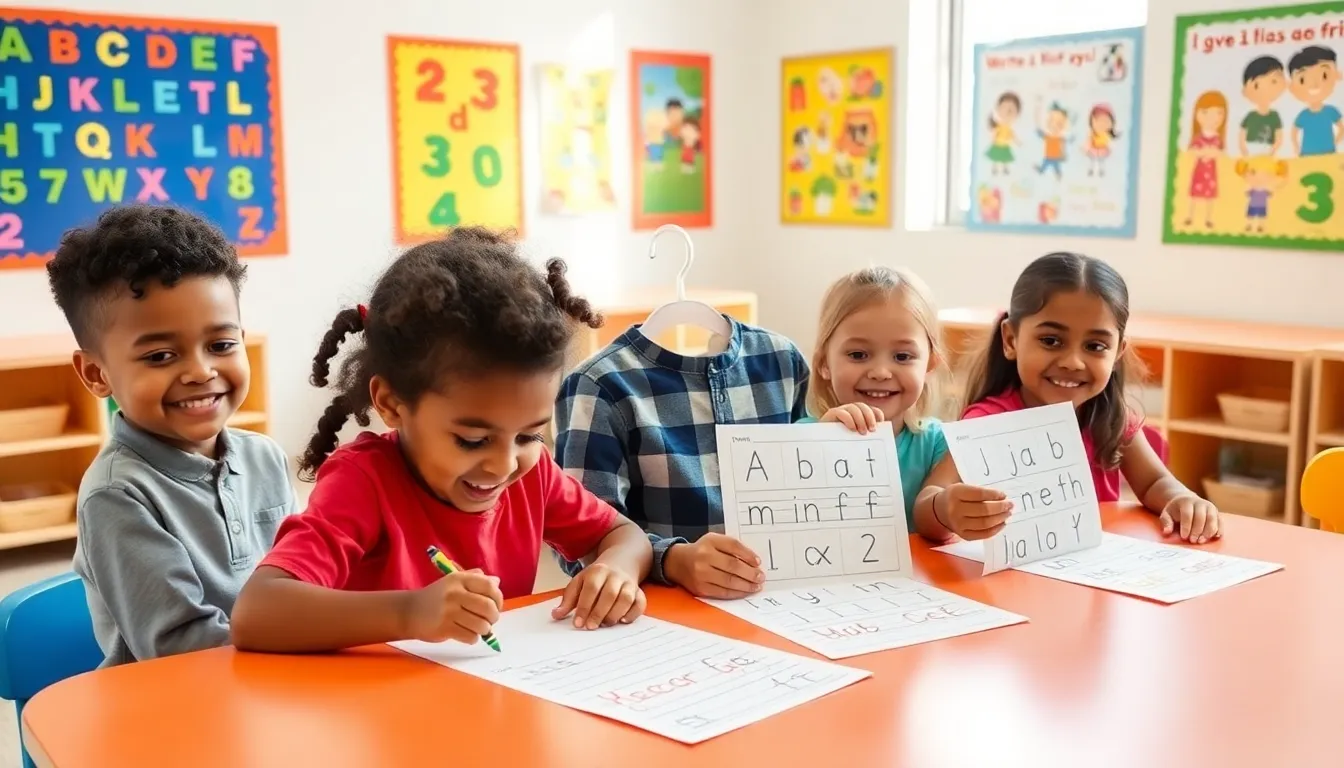Table of Contents
ToggleImagine a world where your little one eagerly showcases their colorful scribbles, presenting them as masterpieces worthy of a gallery. Funny, right? But this scenario isn’t so far-fetched. Writing skills in preschool are pivotal, setting the stage for future academic triumphs. In this text, we jump into the delightful realm of preschool writing worksheets. Not only do these worksheets ignite creativity, they also help develop essential skills that will benefit children for years. Let’s unravel the magic of preschool writing worksheets together.
The Importance of Writing Skills in Preschool

Writing skills are foundational for any child’s early education. Developing these skills does more than prepare them for school: it enhances cognitive abilities as well. When children engage in writing activities, they learn to express themselves, communicate ideas, and build motor control. These skills lay the groundwork for reading and literacy, eventually influencing their academic journey.
In preschool, learning to write isn’t just about forming letters. It’s about exploring language and boosting self-confidence. The joy of making a mark on paper might seem simple, but it opens doors to greater language skills, critical thinking, and even social interaction. Children feel a sense of accomplishment when they see their thoughts transformed into written form, empowering them to share stories and ideas with others.
Types of Preschool Writing Worksheets
Preschool writing worksheets come in various types, each designed to cater to diverse learning needs and styles. Some popular types include:
- Tracing Sheets: These worksheets allow children to practice writing letters, numbers, and shapes through tracing. Tracing helps improve hand-eye coordination and prepares kids for independent writing.
- Letter Formation Worksheets: Focused on proper penmanship, these worksheets guide children in forming letters correctly from start to finish.
- Blank Writing Pages: These offer open-ended opportunities for kids to express their creativity. Children can draw or write freely, allowing them to experiment with words and illustrations.
- Interactive Worksheets: Involving activities like matching letters with pictures or fill-in-the-blank exercises, these worksheets make writing fun and engaging.
- Story Starters: Initiating a young mind’s imagination, these worksheets provide prompts that encourage children to create their own stories.
Benefits of Using Writing Worksheets
Utilizing writing worksheets in preschool offers a treasure trove of benefits. Firstly, they provide structured learning experiences that can be adapted to each child’s pace. This tailored approach fosters a love of writing.
Also, worksheets can help track progress, allowing parents and educators to see improvements in a child’s writing skills. This makes it easier to identify areas that might need extra attention.
Also, writing worksheets encourage fine motor skill development. As children grasp pencils and crayons, they strengthen the muscles in their hands, preparing them for more complex tasks in the future.
Incorporating these worksheets promotes independent learning. Children begin to take ownership of their learning journey, boosting their confidence in their writing abilities.
Tips for Choosing Effective Writing Worksheets
Selecting the right writing worksheets can be as important as using them. Here are some tips to ensure a fruitful learning experience:
- Focus on Age Appropriateness: Choose worksheets suitable for preschoolers. The content should align with their developmental stage to ensure that it is both challenging and achievable.
- Variety is Key: Look for a variety of worksheets to keep learning fresh. Mixing tracing, drawing, and story creation can sustain a child’s interest.
- Interactive Elements: Choose worksheets that encourage hands-on learning. Interactive elements, like stickers or color-by-number, can enhance engagement.
- Clarity of Instructions: Ensure that instructions are clear and straightforward, making it easy for both children and parents to understand what is needed.
- Fun Design: Worksheets adorned with colorful images and playful fonts can capture children’s attention, making writing a visually rewarding experience.
Creative Ideas for Preschool Writing Activities
Integrating creativity into writing activities makes the journey enjoyable and impactful. Here are a few imaginative ideas:
- Story Stones: Paint simple images on stones, then encourage children to create stories based on the stones they pick. This sparks creativity while reinforcing storytelling skills.
- Letter Hunt: Go on a letter hunt in the backyard or local park. Once found, children can use the letters for writing activities, like creating signs or poems.
- Nature Writing: Collect leaves, flowers, or twigs. Children can use their findings to create art and write about their discoveries, merging nature with writing.
- Writing Partnerships: Pair children with a buddy. They can collaborate on stories or worksheets, promoting communication and teamwork.
- Celebrate Writing: Create a ‘Writer’s Wall’ at home or school to display children’s works. This acknowledgment of their efforts motivates them to write with enthusiasm.
How to Incorporate Worksheets into Daily Learning
Integrating writing worksheets into daily routines can be seamless. Here are some strategies:
- Set a Writing Time: Designate a specific time each day for writing activities. Consistency builds habit, making writing a regular part of learning.
- Combine with Other Subjects: Link writing with other subjects. For instance, while learning about animals, kids can write animal descriptions or create drawings of their favorites.
- Use Technology: Consider electronic worksheets or apps for preschoolers that combine writing with interactive fun. These can enhance learning and keep kids engaged.
- Encourage Spontaneity: Let children write about their daily experiences. This can include journaling or drawing, helping them connect their learning to real life.
- Parent Involvement: Engage parents in their child’s writing journey. Provide worksheets that they can work on together at home, fostering a supportive learning environment.





